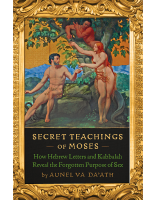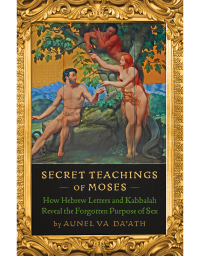The teachings of Moses are pure Kabbalah קבלה.
The word Kabbalah is derived from a Hebrew word that means “to receive.” Kabbalah is the science of everything that exists. The understanding of that science is “received” from God. Real Kabbalah is not invented by anyone. It exists, and can be seen when one awakens consciousness.
As we stated previously, one of the main ways we study Kabbalah is through a symbolic sigil called the Tree of Life. The Tree of Life depicts a series of circles and triangles that symbolically represent dimensionality, consciousness, and interdependence. Each of the circles is what in Hebrew is called a Sephirah ספירה (the plural of which, in Hebrew, is Sephiroth ספירות). Each Sephirah is a world, a vibration, an energy, a level of being, and much more.
Through Kabbalah we understand that the Tree of Life shows us the picture of the whole universe that was made by the Elohim אלהים, according to the Bible.
Instead of “God,” we will use the word Elohim,1 as this is how it is written in the book of Genesis. Here it is in Genesis 1:1:
בראשית ברא אלהים את השמים ואת הארץ
In the beginning, Elohim created Heaven and Earth.
Many translators of the Bible have erroneously translated Elohim as “God.” In actuality, the Hebrew word Elohim is plural (indicated by the suffix “-im ים”) meaning “Gods and Goddesses.”
The second chapter of the book of Genesis shows us a significantly different name for God: Jehovah Elohim יהוה אלהים.
In Kabbalah, Jehovah יהוה is pronounced Jah-Havah, because the name shows the two polarities: Jah יה is masculine and feminine. Havah הוה means “to become” in Aramaic. Havah הוה is read “Eve,” which is also feminine. So, when we say Jah-Havah, we are naming an androgynous entity who is “becoming,” and that is related with the Elohim, which as we stated is plural for Gods and Goddesses. This is how it is written in the second chapter of Genesis, and it is important to understand it in this way.
The translators of the Bible have traditionally translated these names in a monotheistic manner, leading us to believe there is only one God. That is an erroneous interpretation.
Gnostics (those with spiritual experience) understand the multiplicity within the unity, or “monistic polytheism.” Thus, if we want to apply the monotheistic manner of present translations of Genesis, then we need to understand that within the unity of the One God there is a multiplicity. If we think in a polytheistic manner, we understand that within the multiple Gods there is a unity. This is how we have to understand and comprehend the book of Genesis, which is a book of the Gnostics.
Genesis means “generation.” It is a book of Alchemy written in a very cryptic manner; this in order that it only be understood by initiates.
The Zohar, a book written by the great masters of Kabbalah, explains all the mysteries of Genesis. It is not possible to understand the explanations of these masters without walking on the path and awakening consciousness, because their explanations are kabbalistic. Indeed, this is precisely the same case that we find with the elucidations found in The Pistis Sophia, written by the apostles of Jesus Christ. This book explains everything in a kabbalistic manner, thus if someone does not know Kabbalah, they fall into error. Therefore, since we are giving the knowledge to humanity, we require people to study the Tree of Life, because that is the only way to understand these kabbalistic books.







